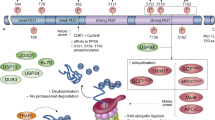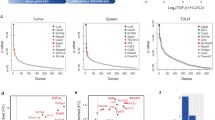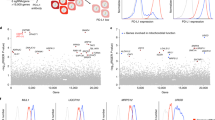Abstract
Bcl-xL plays a critical role in maintaining cell survival. However, the relationship between the potential interaction of Bcl-xL with other cytosolic proteins and the regulation of cell survival remains incompletely defined. We have identified translationally controlled tumor protein (TCTP), a multifunctional protein, as a novel antiapoptotic Bcl-xL-interacting protein. TCTP interacted in vivo and in vitro with Bcl-xL, and their sites have been mapped to an N-terminal region of TCTP and the Bcl-2 homology domain 3 of Bcl-xL. Consistent with a role in maintaining T-cell survival during activation, TCTP was significantly upregulated in murine T cells activated by T-cell antigen receptor (TCR) ligation and CD28 costimulation, which was correlated with the upregulation of Bcl-xL in activated T cells. Moreover, downregulation of TCTP expression by antisense technology in T cells results in the increase of T-cell apoptosis. Furthermore, the N-terminal region of TCTP was required for its ability to inhibit apoptosis. In conclusion, this study has demonstrated that an N-terminal region of a cytosolic protein, TCTP, is required for its binding to Bcl-xL and for its antiapoptotic activity.
This is a preview of subscription content, access via your institution
Access options
Subscribe to this journal
Receive 50 print issues and online access
$259.00 per year
only $5.18 per issue
Buy this article
- Purchase on Springer Link
- Instant access to full article PDF
Prices may be subject to local taxes which are calculated during checkout




Similar content being viewed by others
Abbreviations
- TCTP:
-
translationally controlled tumor protein
- BH3 domain:
-
Bcl-2 homology domain 3
- TNT:
-
in vitro transcription and translation
- GST:
-
glutathione S-transferase
References
Adams JM . (2003). Genes Dev., 17, 2481–2495.
Adams P, Seeholzer S and Ohh M . (2002). A Molecular Cloning Manual: Protein–Protein Interactions. Golemis E (ed). Cold Spring Harbor Laboratory Press: Cold Spring Harbor, NY, pp. 59–74.
Amzallag N, Passer BJ, Allanic D, Segura E, Thery C, Goud B, Amson R and Telerman A . (2004). J. Biol. Chem., 279, 46104–46112.
Aumais JP, Williams SN, Luo W, Nishino M, Caldwell KA, Caldwell GA, Lin SH and Yu-Lee LY . (2003). J. Cell Sci., 116, 1991–2003.
Bae J, Donigian JR and Hsueh AJ . (2003). J. Biol. Chem., 278, 5195–5204.
Bae J, Leo CP, Hsu SY and Hsueh AJ . (2000). J. Biol. Chem., 275, 25255–25261.
Bangrak P, Graidist P, Chotigeat W and Phongdara A . (2004). J. Biotechnol., 108, 219–226.
Basu A and Haldar S . (2003). FEBS Lett., 538, 41–47.
Baudet C, Perret E, Delpech B, Kaghad M, Brachet P, Wion D and Caput D . (1998). Cell Death Differ., 5, 116–125.
Biswas RS, Cha HJ, Hardwick JM and Srivastava RK . (2001). Mol. Cell. Biochem., 225, 7–20.
Blagosklonny MV and Fojo T . (1999). Int. J. Cancer, 83, 151–156.
Boise LH, Gonzalez-Garcia M, Postema CE, Ding L, Lindsten T, Turka LA, Mao X, Nunez G and Thompson CB . (1993). Cell, 74, 597–608.
Boise LH, Minn AJ, Noel PJ, June CH, Accavitti MA, Lindsten T and Thompson CB . (1995). Immunity, 3, 87–98.
Bommer UA and Thiele BJ . (2004). Int. J. Biochem. Cell Biol., 36, 379–385.
Borner C . (2003). Mol. Immunol., 39, 615–647.
Cans C, Passer BJ, Shalak V, Nancy-Portebois V, Crible V, Amzallag N, Allanic D, Tufino R, Argentini M, Moras D, Fiucci G, Goud B, Mirande M, Amson R and Telerman A . (2003). Proc. Natl. Acad. Sci. USA, 100, 13892–13897.
Diaz JL, Oltersdorf T, Horne W, McConnell M, Wilson G, Weeks S, Garcia T and Fritz LC . (1997). J. Biol. Chem., 272, 11350–11355.
Einarson M and Orlinick JR . (2002). Identification of Protein–Protein Interactions with Glutathione-S-Transferase Fusion Proteins. Cold Spring Habor Laboratory Press: Cold Spring Harbor, NY.
Fang W, Rivard JJ, Mueller DL and Behrens TW . (1994). J. Immunol., 153, 4388–4398.
Gachet Y, Tournier S, Lee M, Lazaris-Karatzas A, Poulton T and Bommer UA . (1999). J. Cell Sci., 112 (Part 8), 1257–1271.
Gibbs CS and Zoller MJ . (1991). J. Biol. Chem., 266, 8923–8931.
Gonzalez-Garcia M, Perez-Ballestero R, Ding L, Duan L, Boise LH, Thompson CB and Nunez G . (1994). Development, 120, 3033–3042.
Graidist P, Phongdara A and Fujise K . (2004). J. Biol. Chem., 279, 40868–40875.
Hsu YT, Wolter KG and Youle RJ . (1997). Proc. Natl. Acad. Sci. USA, 94, 3668–3672.
Jeong SY, Gaume B, Lee YJ, Hsu YT, Ryu SW, Yoon SH and Youle RJ . (2004). EMBO J., 23, 2146–2155.
Jung J, Kim M, Kim MJ, Kim J, Moon J, Lim JS and Lee K . (2004). J. Biol. Chem., 279, 49868–49875.
Kamath RS, Fraser AG, Dong Y, Poulin G, Durbin R, Gotta M, Kanapin A, Le Bot N, Moreno S, Sohrmann M, Welchman DP, Zipperlen P and Ahringer J . (2003). Nature, 421, 231–237.
Kang HS, Lee MJ, Song H, Han SH, Kim YM, Im JY and Choi I . (2001). J. Immunol., 166, 6545–6554.
Kim M, Jung Y, Lee K and Kim C . (2000). Arch. Pharm. Res., 23, 633–636.
Komatsu K, Miyashita T, Hang H, Hopkins KM, Zheng W, Cuddeback S, Yamada M, Lieberman HB and Wang HG . (2000). Nat. Cell Biol., 2, 1–6.
Li F, Zhang D and Fujise K . (2001). J. Biol. Chem., 276, 47542–47549.
Li TK and Liu LF . (2001). Annu. Rev. Pharmacol. Toxicol., 41, 53–77.
Ma A, Pena JC, Chang B, Margosian E, Davidson L, Alt FW and Thompson CB . (1995). Proc. Natl. Acad. Sci. USA, 92, 4763–4767.
Marrack P and Kappler J . (2004). Annu. Rev. Immunol., 22, 765–787.
Mihara K . (2000). BioEssays, 22, 364–371.
Motoyama N, Wang F, Roth KA, Sawa H, Nakayama K, Negishi I, Senju S, Zhang Q, Fujii S and Loh DY . (1995). Science, 267, 1506–1510.
Nickel W . (2003). Eur. J. Biochem., 270, 2109–2119.
Opferman JT and Korsmeyer SJ . (2003). Nat. Immunol., 4, 410–415.
Schwartz RH . (2003). Annu. Rev. Immunol., 21, 305–334.
Sedlak TW, Oltvai ZN, Yang E, Wang K, Boise LH, Thompson CB and Korsmeyer SJ . (1995). Proc. Natl. Acad. Sci. USA, 92, 7834–7838.
Shangary S and Johnson DE . (2002). Biochemistry, 41, 9485–9495.
Shim J and Karin M . (2002). Mol. Cells, 14, 323–331.
Thaw P, Baxter NJ, Hounslow AM, Price C, Waltho JP and Craven CJ . (2001). Nat. Struct. Biol., 8, 701–704.
Tuynder M, Fiucci G, Prieur S, Lespagnol A, Geant A, Beaucourt S, Duflaut D, Besse S, Susini L, Cavarelli J, Moras D, Amson R and Telerman A . (2004). Proc. Natl. Acad. Sci. USA, 101, 15364–15369.
Vonakis BM, Sora R, Langdon JM, Casolaro V and MacDonald SM . (2003). J. Immunol., 171, 3742–3750.
Wildin RS, Wang HU, Forbush KA and Perlmutter RM . (1995). J. Immunol., 155, 1286–1295.
Yang J, Liu X, Bhalla K, Kim CN, Ibrado AM, Cai J, Peng TI, Jones DP and Wang X . (1997a). Science, 275, 1129–1132.
Yang XF, Weber GF and Cantor H . (1997b). Immunity, 7, 629–639.
Yang XF, Wu CJ, McLaughlin S, Chillemi A, Wang KS, Canning C, Alyea EP, Kantoff P, Soiffer RJ, Dranoff G and Ritz J . (2001). Proc. Natl. Acad. Sci. USA, 98, 7492–7497.
Yang X-F, Ye Q, Press B, Han RZ, Bassing CH, Sleckman BP, Alt FW and Cantor H . (2002). Mol. Immunol., 39, 45–55.
Yarm FR . (2002). Mol. Cell. Biol., 22, 6209–6221.
Ye Q, Press B, Kissler S, Yang XF, Lu L, Bassing CH, Sleckman BP, Jansson M, Panoutsakopoulou V, Trimble LA, Alt FW and Cantor H . (2002). J. Exp. Med., 196, 87–95.
Yoon T, Jung J, Kim M, Lee KM, Choi EC and Lee K . (2000). Arch. Biochem. Biophys., 384, 379–382.
Zhang D, Li F, Weidner D, Mnjoyan ZH and Fujise K . (2002). J. Biol. Chem., 277, 37430–37438.
Zhang H, Xu Q, Krajewski S, Krajewska M, Xie Z, Fuess S, Kitada S, Godzik A and Reed JC . (2000). Proc. Natl. Acad. Sci. USA, 97, 2597–2602.
Acknowledgements
We are grateful to Drs DP Huston, L-Y Yu-Lee, TH Tan, S Zhang, B Ng, H Lu, and JP Aumais at Baylor, H Cantor and J Ritz at Harvard, Dr SM MacDonald at the Johns Hopkins, and Drs E Guillaume and JC Sanchez at Hopital Cantonal Universitaire de Geneve for suggestion or reagents, Drs MA Mancini and F Kheradmand at Baylor for the use of confocal and fluorescence microscopes, and Ms K Franks and her associates in our section for assistance. This work was partially supported by funds from NIH Grants AI054514, P30 DK56238, and P20 CA103698, development support at Baylor, the Kostas Foundation, the Law Foundation, the Myositis Association of America, the American Heart Association-Texas Affiliate, and the Leukemia & Lymphoma Society and Myeloproliferative Disorders Foundation. X-F Yang is a Chao Family Scholar of Medicine.
Author information
Authors and Affiliations
Corresponding author
Rights and permissions
About this article
Cite this article
Yang, Y., Yang, F., Xiong, Z. et al. An N-terminal region of translationally controlled tumor protein is required for its antiapoptotic activity. Oncogene 24, 4778–4788 (2005). https://doi.org/10.1038/sj.onc.1208666
Received:
Revised:
Accepted:
Published:
Issue Date:
DOI: https://doi.org/10.1038/sj.onc.1208666
Keywords
This article is cited by
-
Fortilin interacts with TGF-β1 and prevents TGF-β receptor activation
Communications Biology (2022)
-
Fortilin inhibits p53, halts cardiomyocyte apoptosis, and protects the heart against heart failure
Cell Death Discovery (2021)
-
Comparative modelling unravels the structural features of eukaryotic TCTP implicated in its multifunctional properties: an in silico approach
Journal of Molecular Modeling (2021)
-
Molecular isolation and characterization of translationally controlled tumor protein (TCTP) gene from Macrobrachium rosenbergii
Aquaculture International (2020)
-
Identification of translationally controlled tumor protein in promotion of DNA homologous recombination repair in cancer cells by affinity proteomics
Oncogene (2017)



